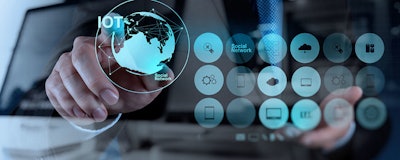
 Tony Christian
Tony ChristianThe past few years have seen IT systems moving away from advances in individual functionality to interoperability with complementary systems. In addition, there's been a greater emphasis on "democratization" of applications — improving accessibility through cloud-based architectures, mobile computing, lower pricing models and improved user interfaces. We have also seen end products themselves becoming ever smarter through embedded software, making them able to react to their environment and transmit information back to supporting systems.
All of these trends are coming together under the banner of what is likely to be the big theme in the supply chain world for 2016 — the Internet of Things or IoT.
Supply Chain IoT
Gartner's Hype Cycle currently has the IoT at the "peak of inflated expectations" stage. That may be, but the potential for IoT-enabled supply chains is still huge.
For example:
- closer tracking of the movement and condition of delivery consignments will enable better management of supply chains involving perishable goods
- in construction, the ability to find and track materials in delivery as well as on site will help to avoid major schedule disruptions
- Smart products connected to the IoT offers great potential for the post-delivery supply chain, too.
An obvious opportunity is in-service condition and performance monitoring. This is the area in which there are most examples today, with perhaps the most extreme one being continuous in-flight monitoring of aero engines.
Analyzing the data from in-field devices flags potential problems while avoiding unnecessary maintenance. But in-field performance analysis has many other benefits. Data from the field can be used to inform design improvements, or to ensure that a product is being used properly.
How Does PLM Fit In?
Connected devices also enable “over-the-air” product upgrades.
If product features are implemented with software, new ones can be delivered using over-the-air upgrades (assuming that the user wants them). This capability extends to remote “localization” of the product, too — the product “phones home” to find out what settings it should adopt.
For the product development supply chain, the implication of smart, connected devices is the presence of embedded software and the consequent need to manage the lifecycle of that software.
So the scope of product definition is changing.
PLM now has to manage the development of products with hard, soft, electrical and electronic components — making it essential to making the benefits of the IoT real.
Furthermore, the importance of the service provision is changing as producers undertake in-service monitoring, providing incremental improvements to products at the same time.
As software/firmware updates become a standard part of the service lifecycle, products will need to be defined in a way that allows for future modifications and accommodates sufficient scope for change.
The management of information over a product’s lifetime will become much more complex as products become more customizable, highly instrumented and monitored.
Product performance data, whether flow and temperature in a process plant, structural deformation of structures or energy consumption in communications equipment, can be processed for short-term corrective action but also for re-simulation as part of long-term continuous improvement and next-generation design.
In response to these drivers, PLM software suppliers are expanding their portfolios to include systems and software engineering tools.
The Outlook
The claims for the IoT are indeed high. But it’s essentially a conceptual wrapper for the exploitation of a number of technologies — application software, embedded software, mobile computing, connectivity and analytics — and for each company, the appropriate mix must be determined using the same kind of business approach as for any large IT investment.
It will be very interesting to see the emergence of early use cases growing into “standardized solutions” for given applications.
Tony Christian is Managing Director at Cambashi.























